Abstract
The history of the relationship of biological activity to partition coefficient and related properties is briefly reviewed. The dominance of partition coefficient in quantitation of structure-activity relationships is emphasized, although the importance of other factors is also demonstrated. Various mathematical models of in vivo transport and binding are discussed; most of these involve partitioning as the primary mechanism of transport. The models describe observed quantitative structure-activity relationships (QSARs) well on the whole, confirming that partitioning is of key importance in in vivo behavior of a xenobiotic. The partition coefficient is shown to correlate with numerous other parameters representing bulk, such as molecular weight, volume and surface area, parachor and calculated indices such as molecular connectivity; this is especially so for apolar molecules, because for polar molecules lipophilicity factors into both bulk and polar or hydrogen bonding components. The relationship of partition coefficient to chromatographic parameters is discussed, and it is shown that such parameters, which are often readily obtainable experimentally, can successfully supplant partition coefficient in QSARs. The relationship of aqueous solubility with partition coefficient is examined in detail. Correlations are observed, even with solid compounds, and these can be used to predict solubility. The additive/constitutive nature of partition coefficient is discussed extensively, as are the available schemes for the calculation of partition coefficient. Finally the use of partition coefficient to provide structural information is considered. It is shown that partition coefficient can be a valuable structural tool, especially if the enthalpy and entropy of partitioning are available.
Full text
PDF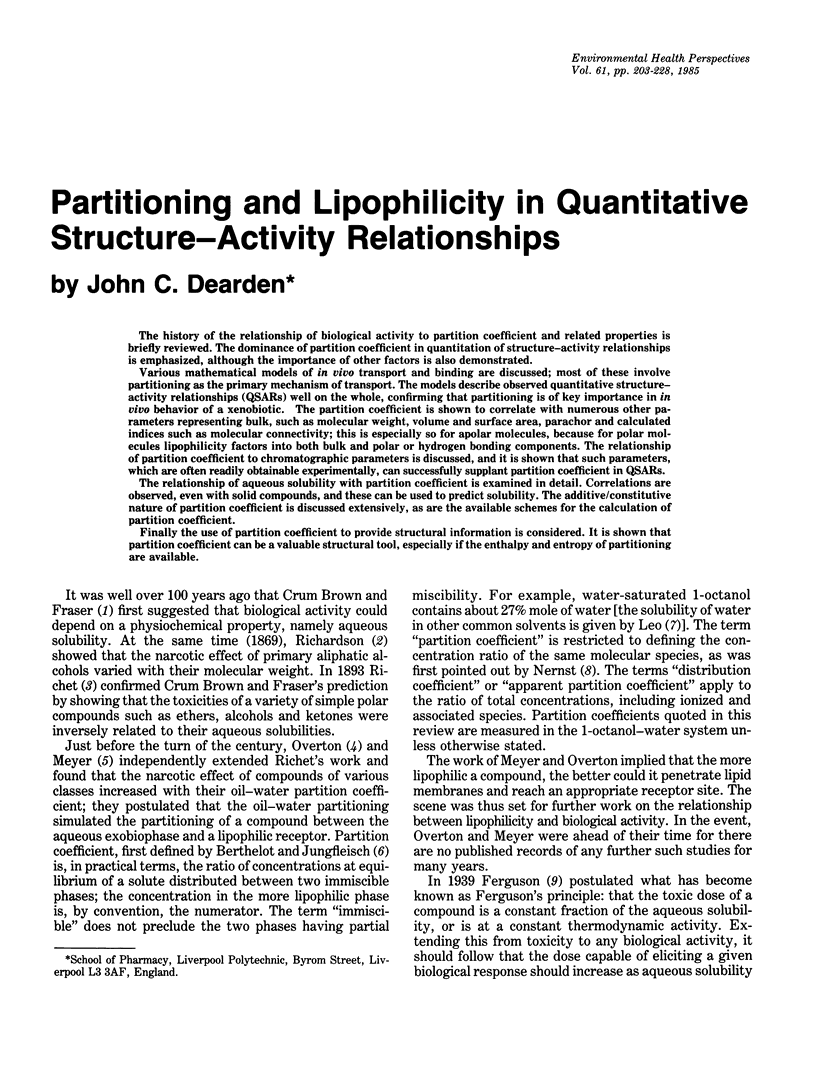
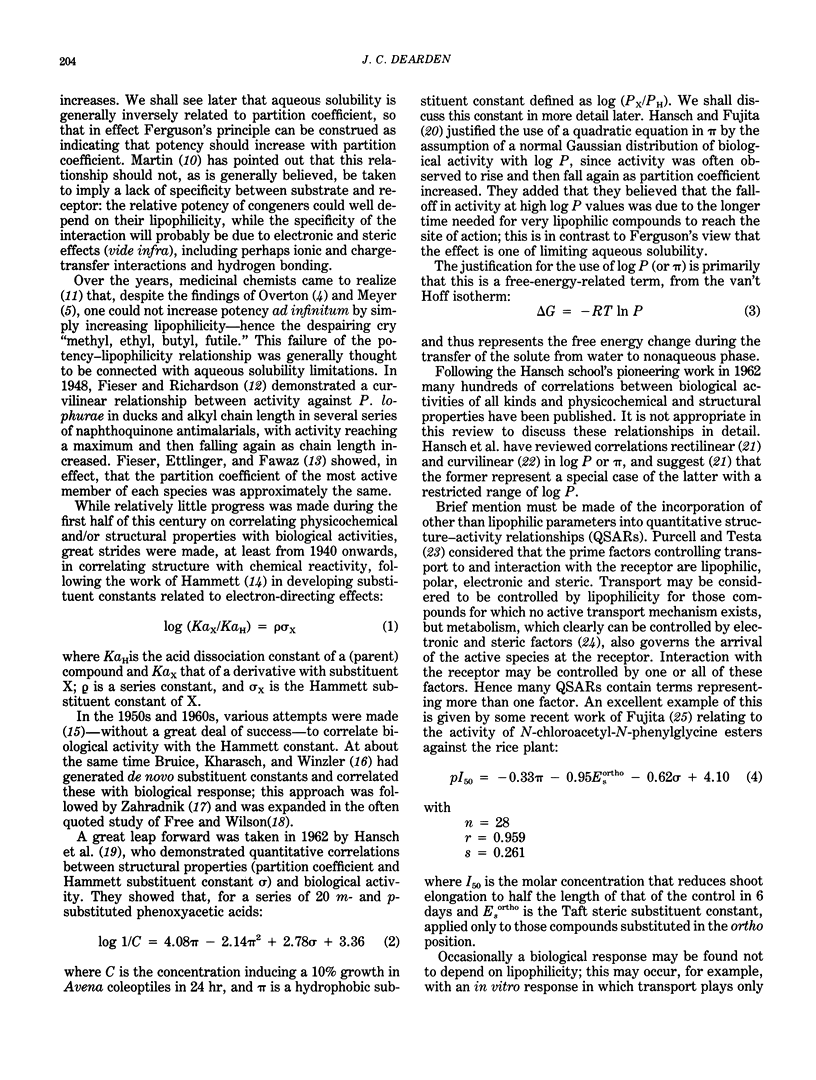
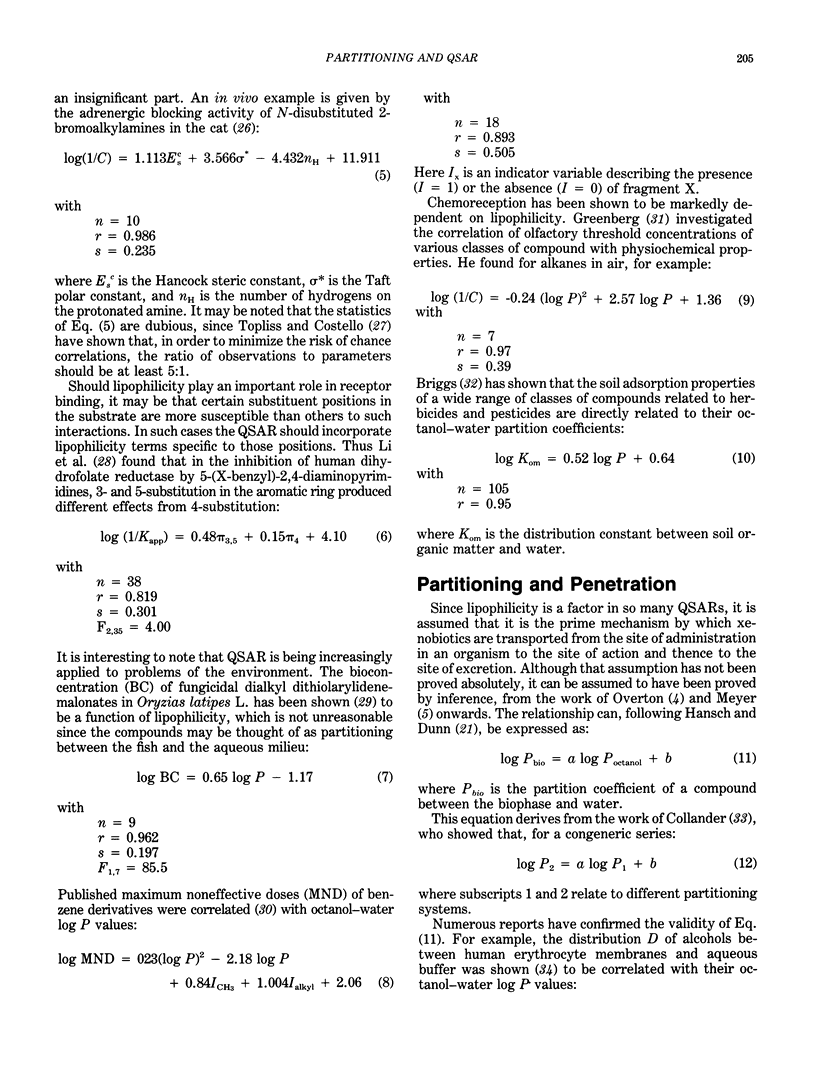
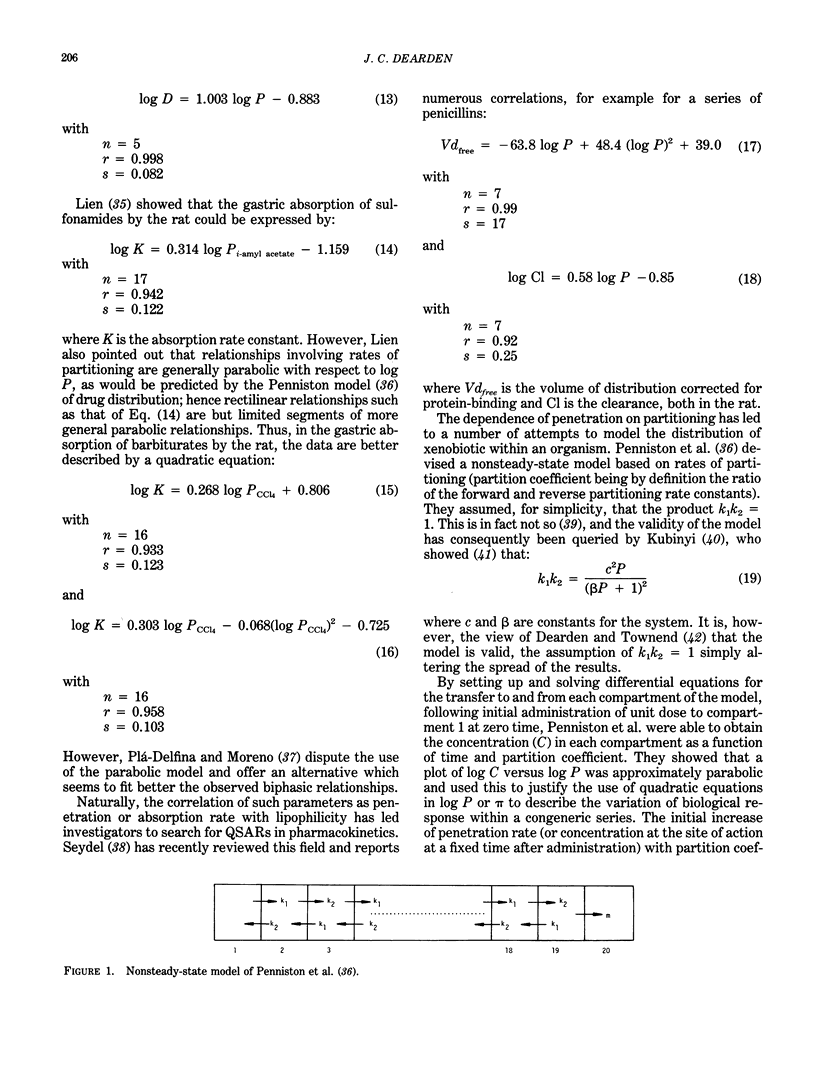
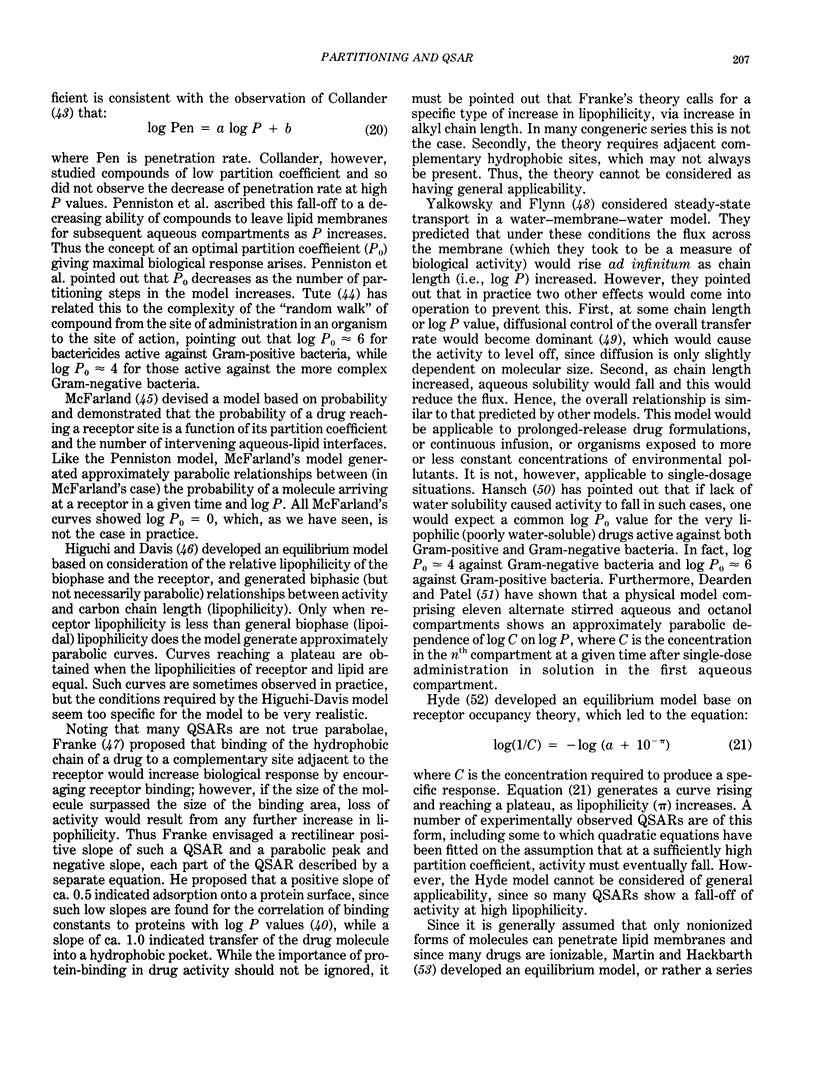
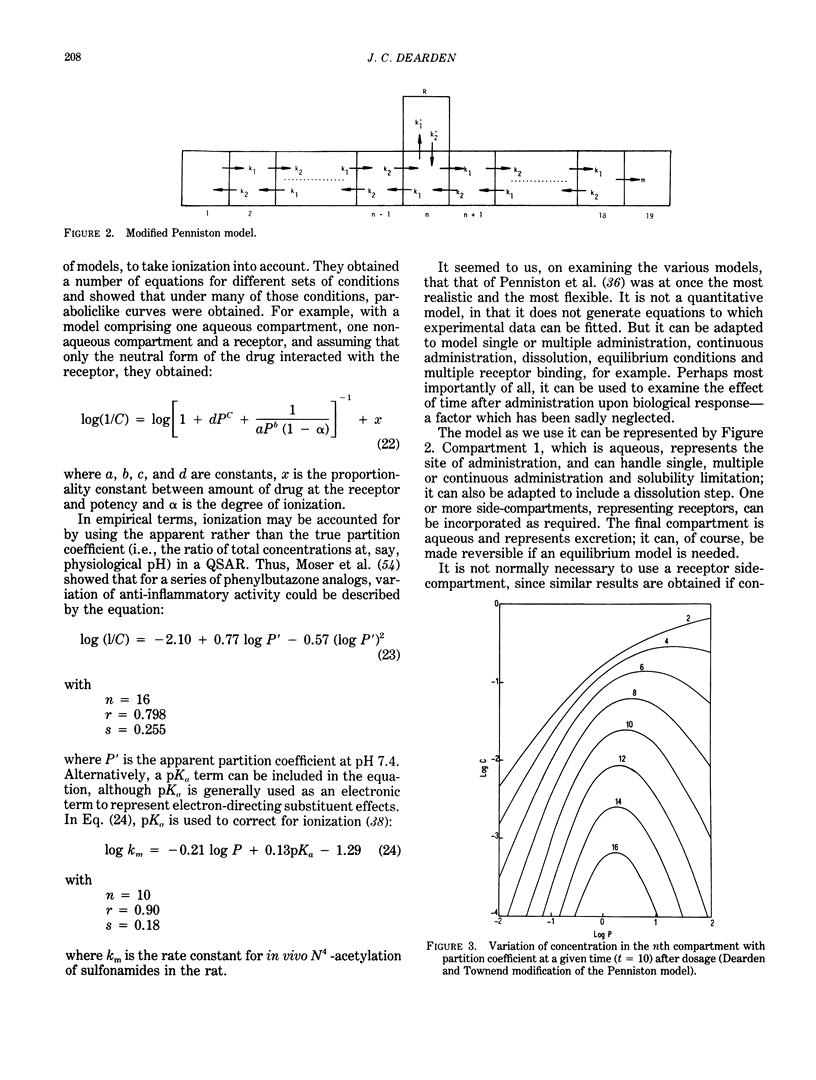
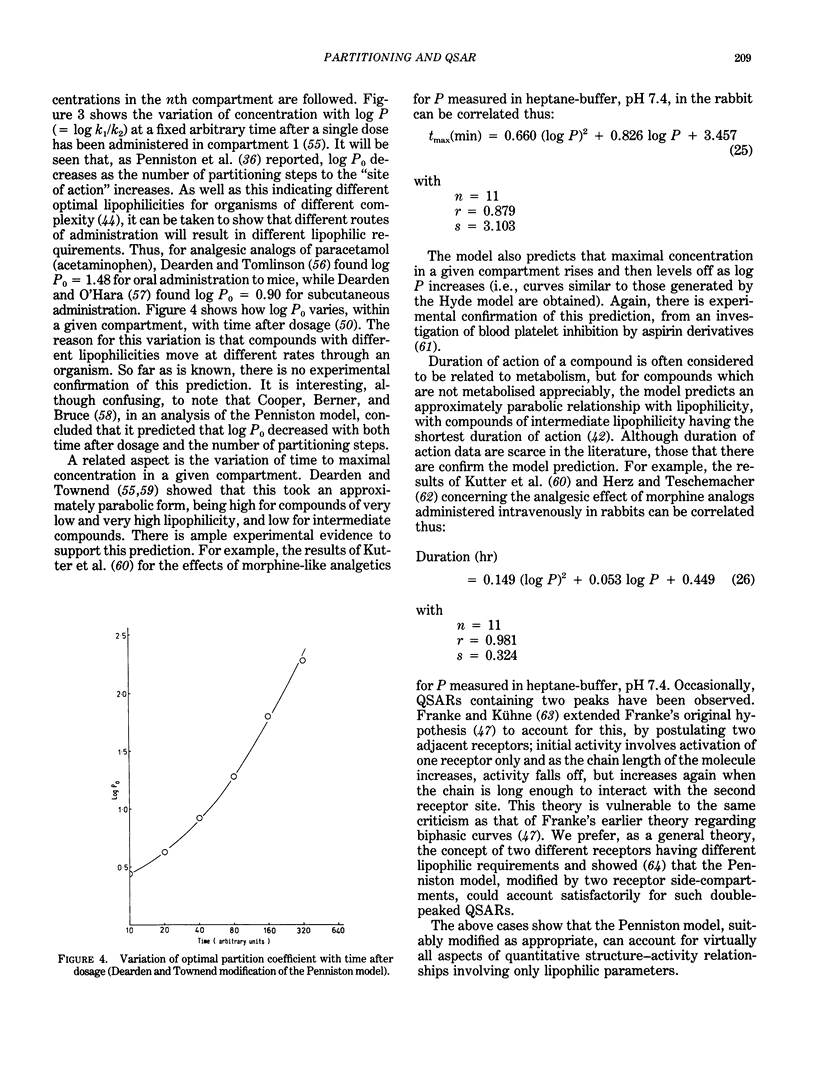
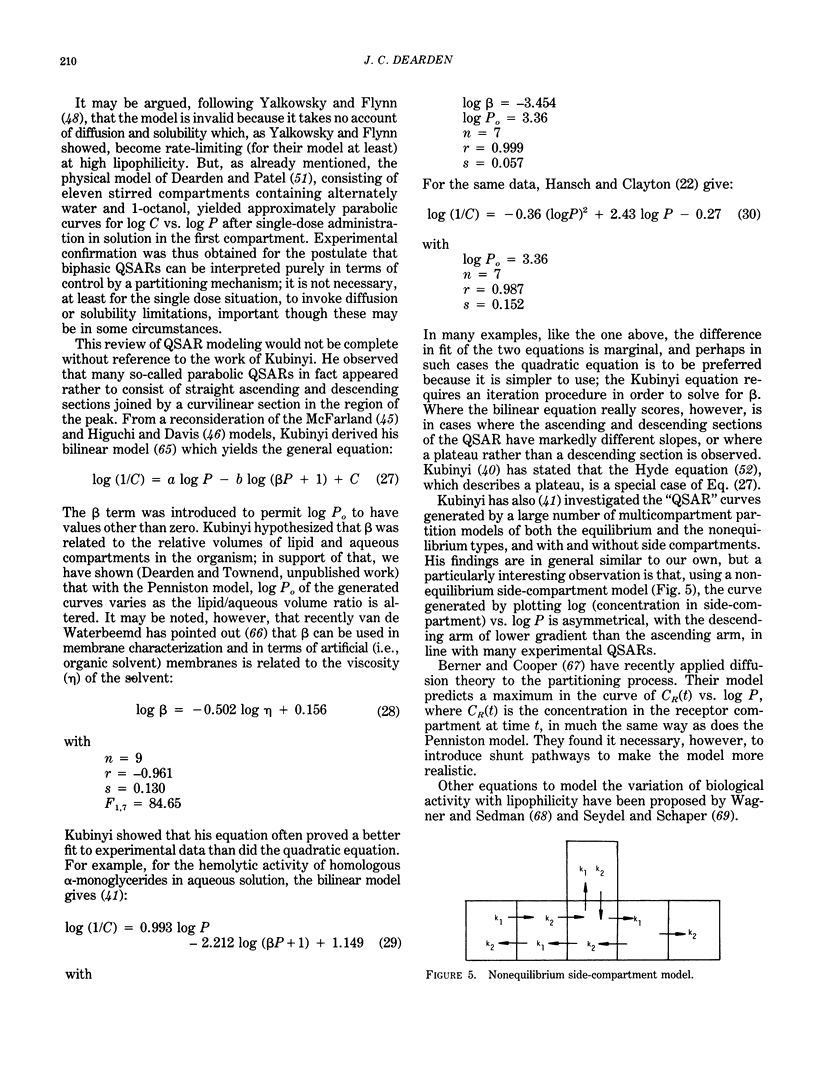
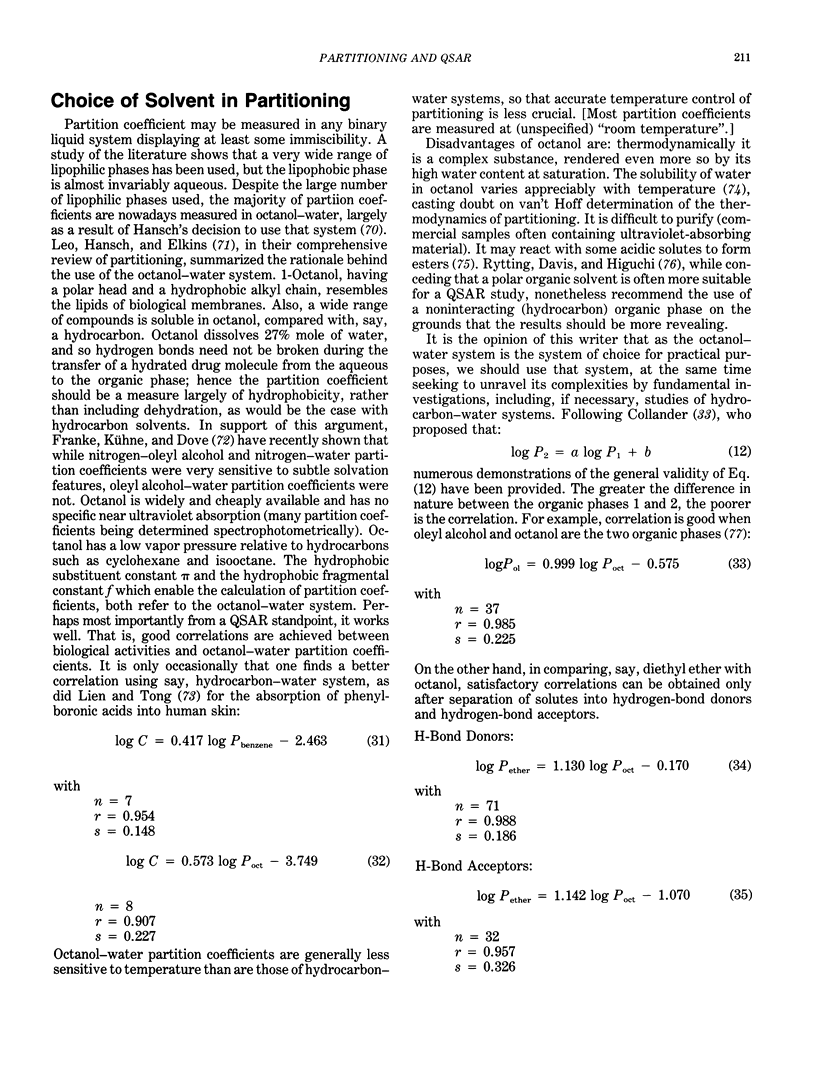
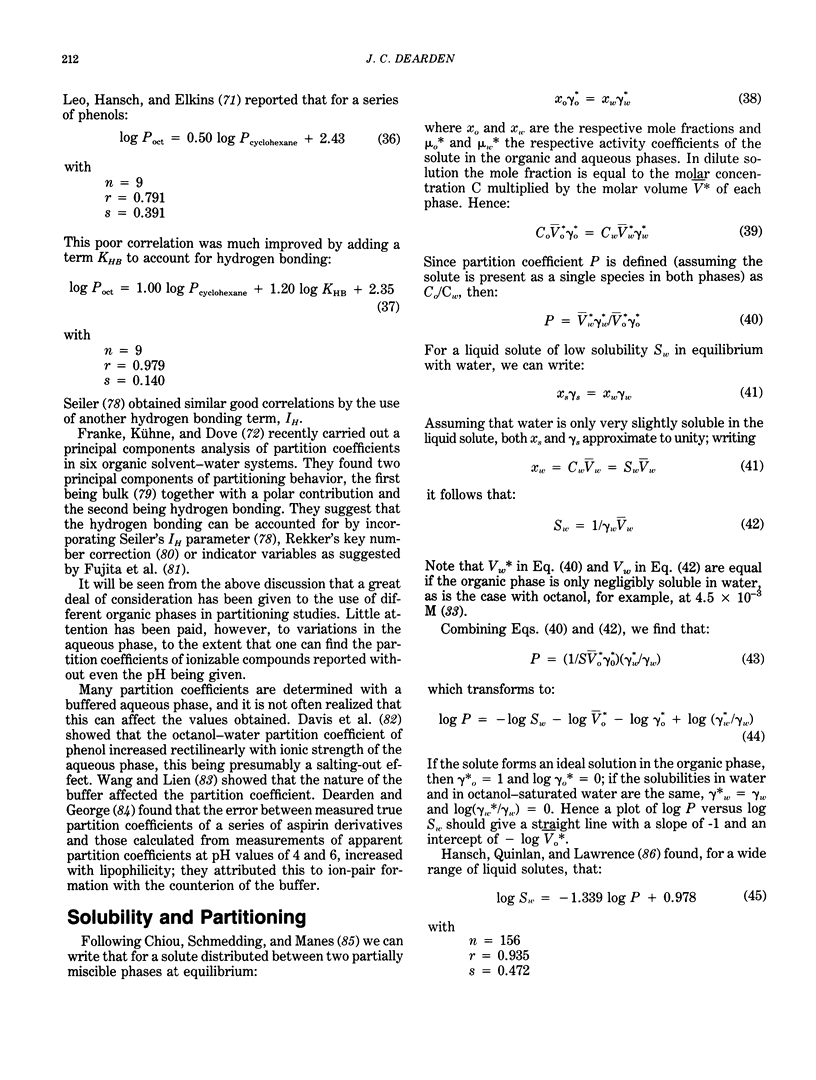
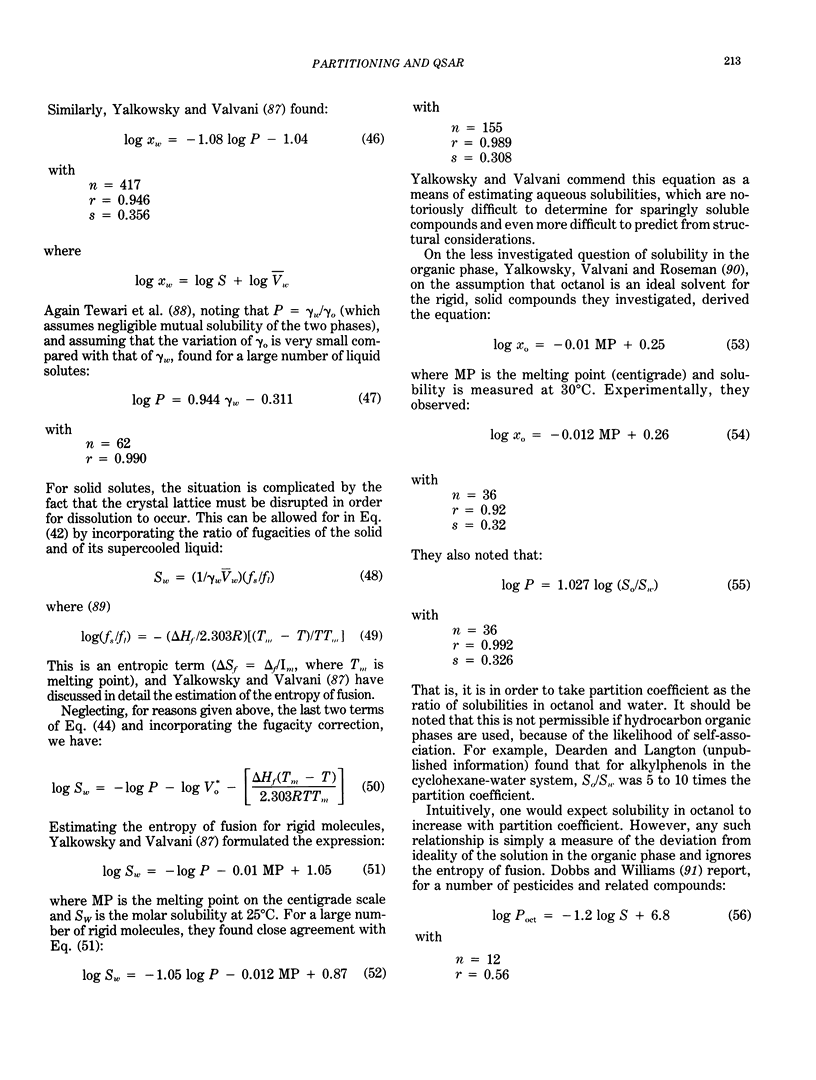
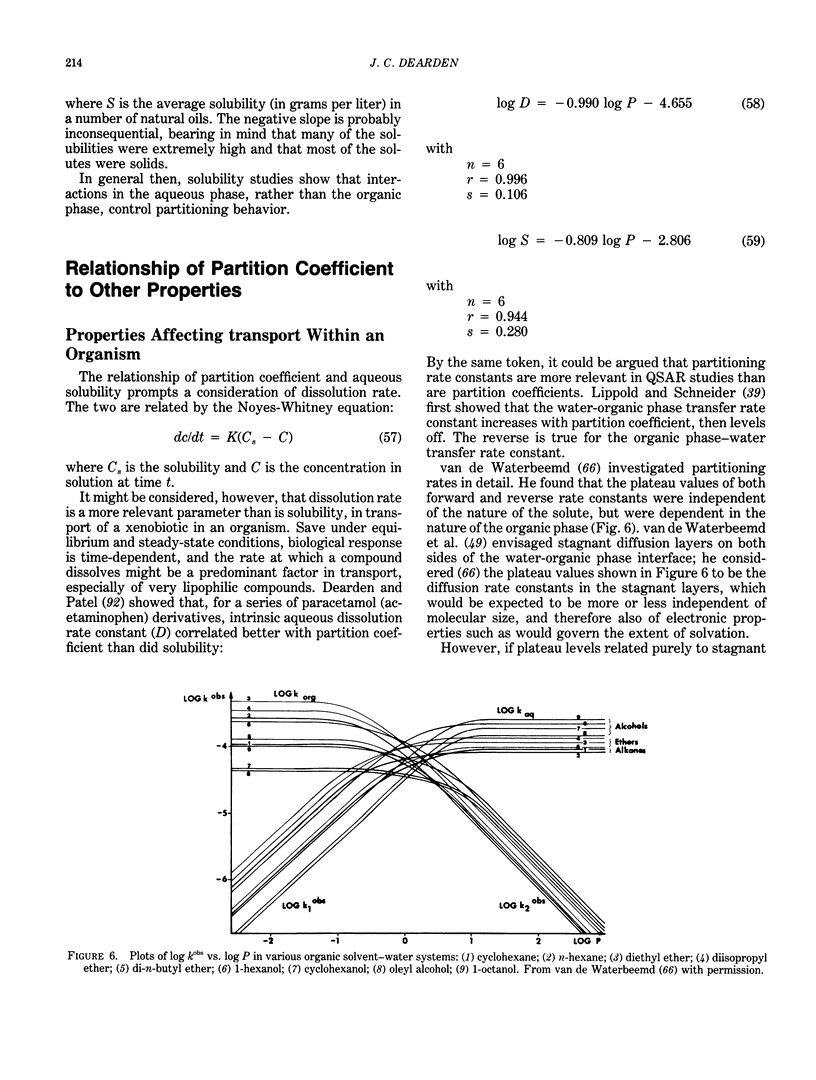
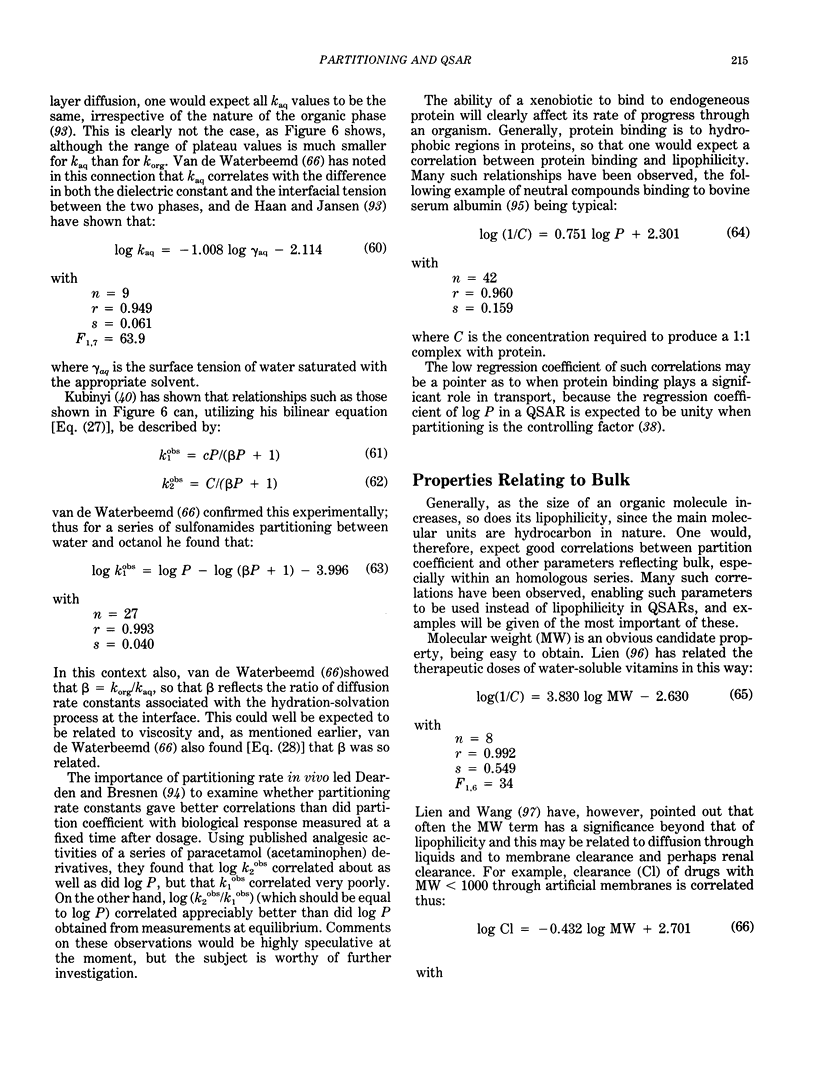
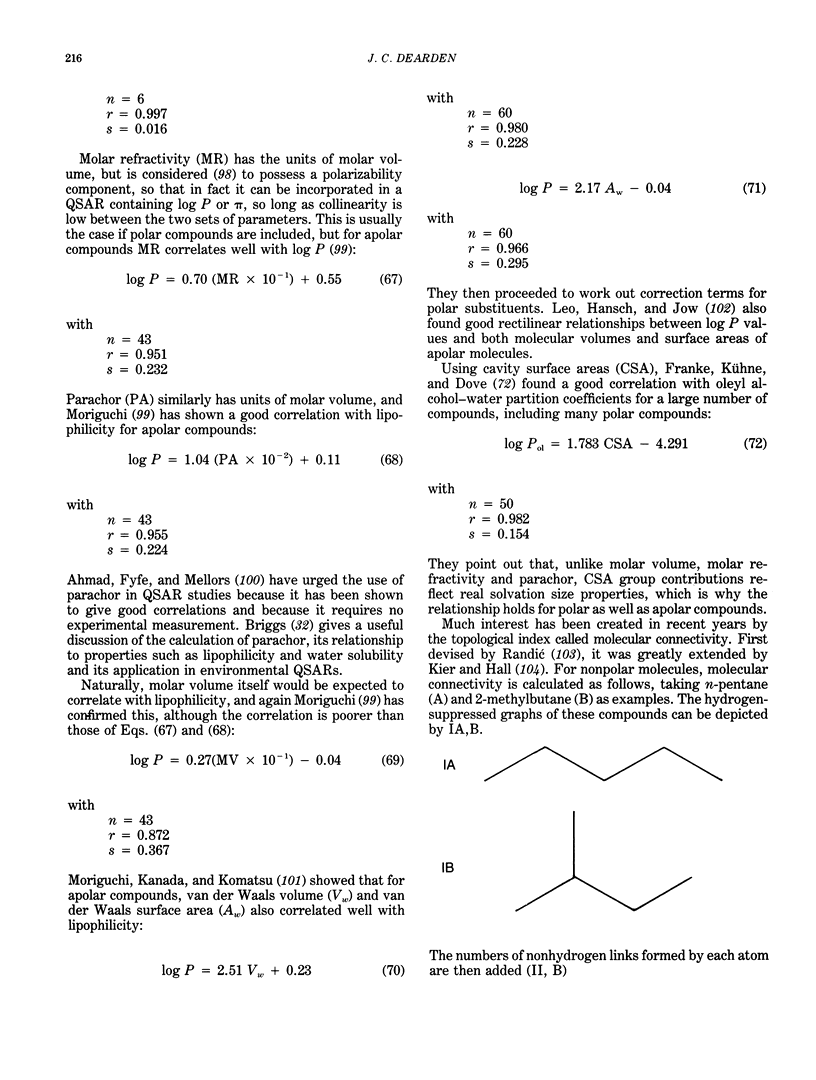
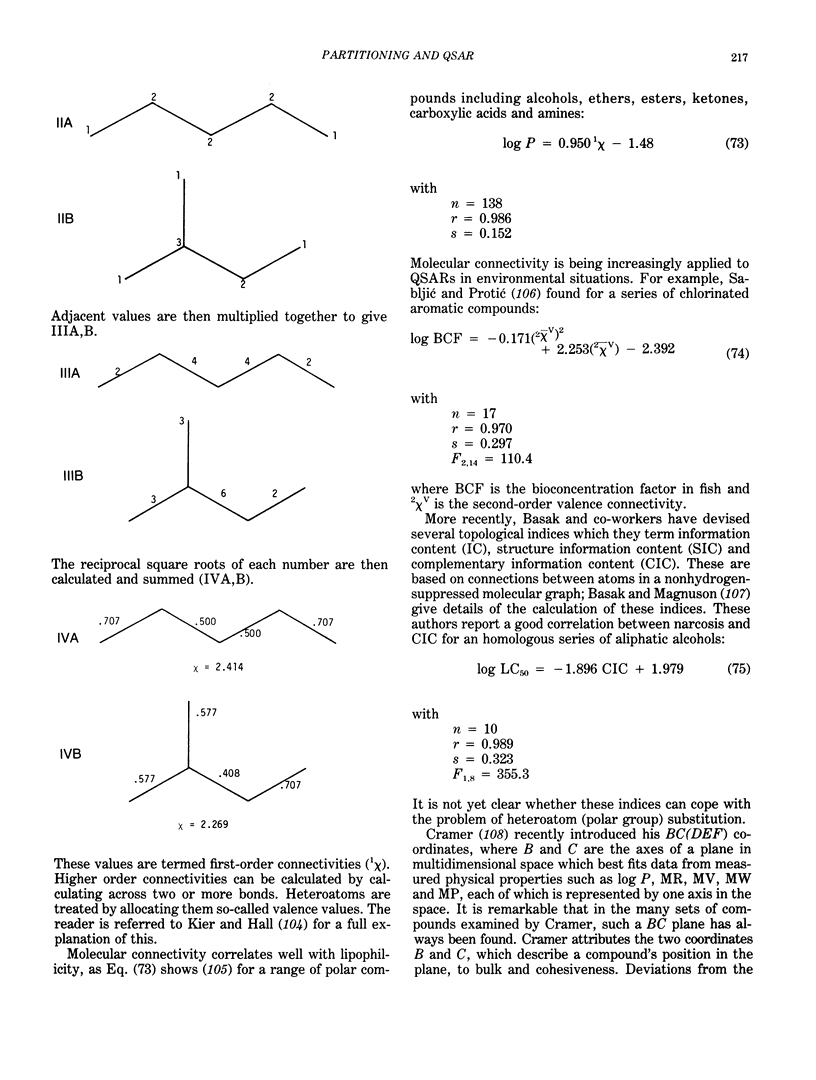
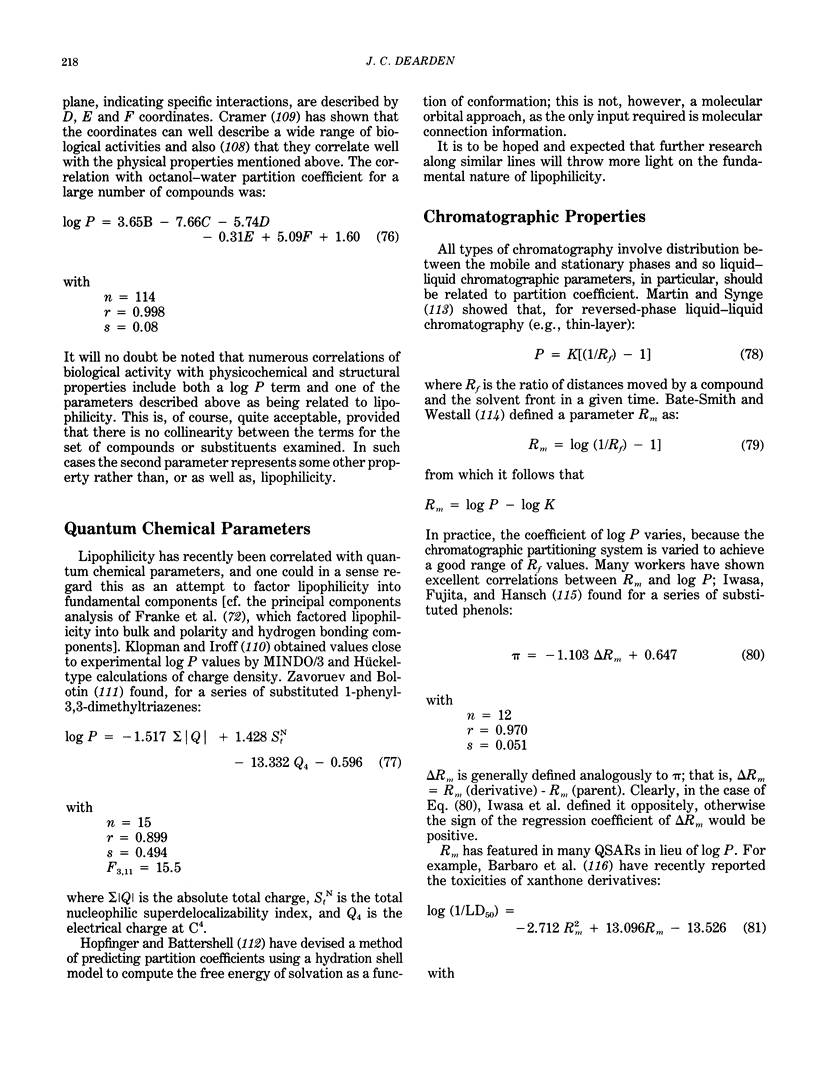
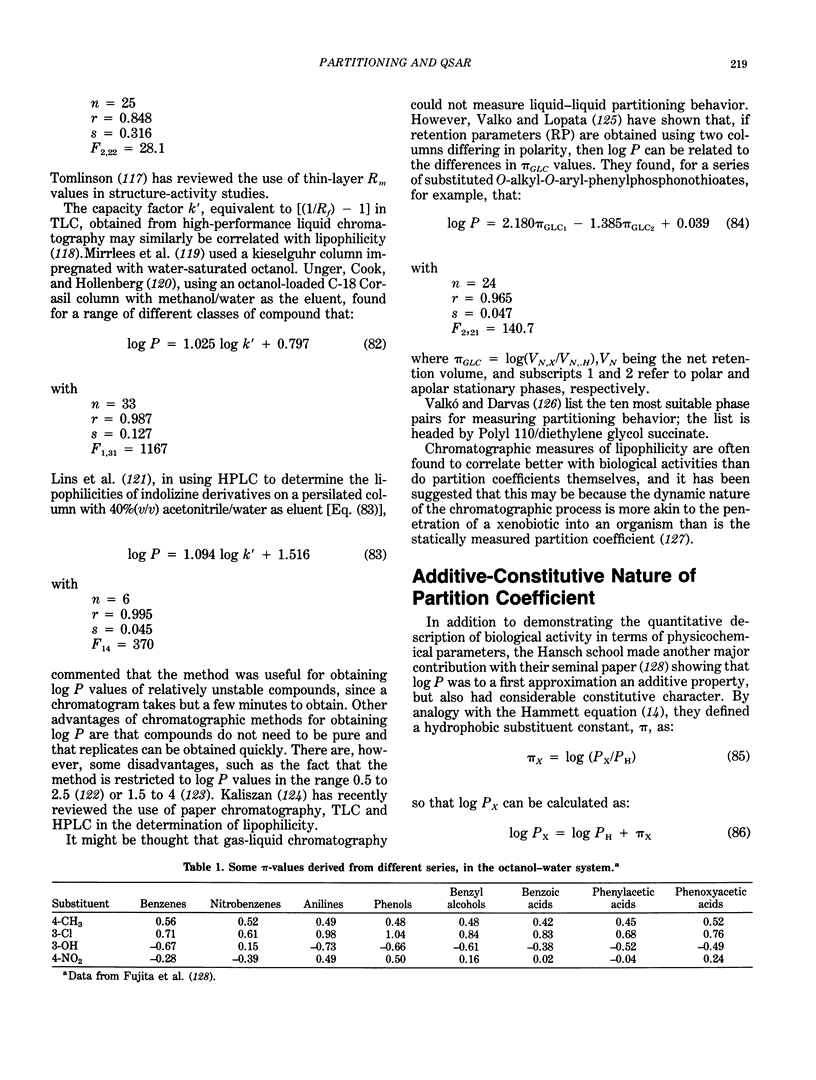
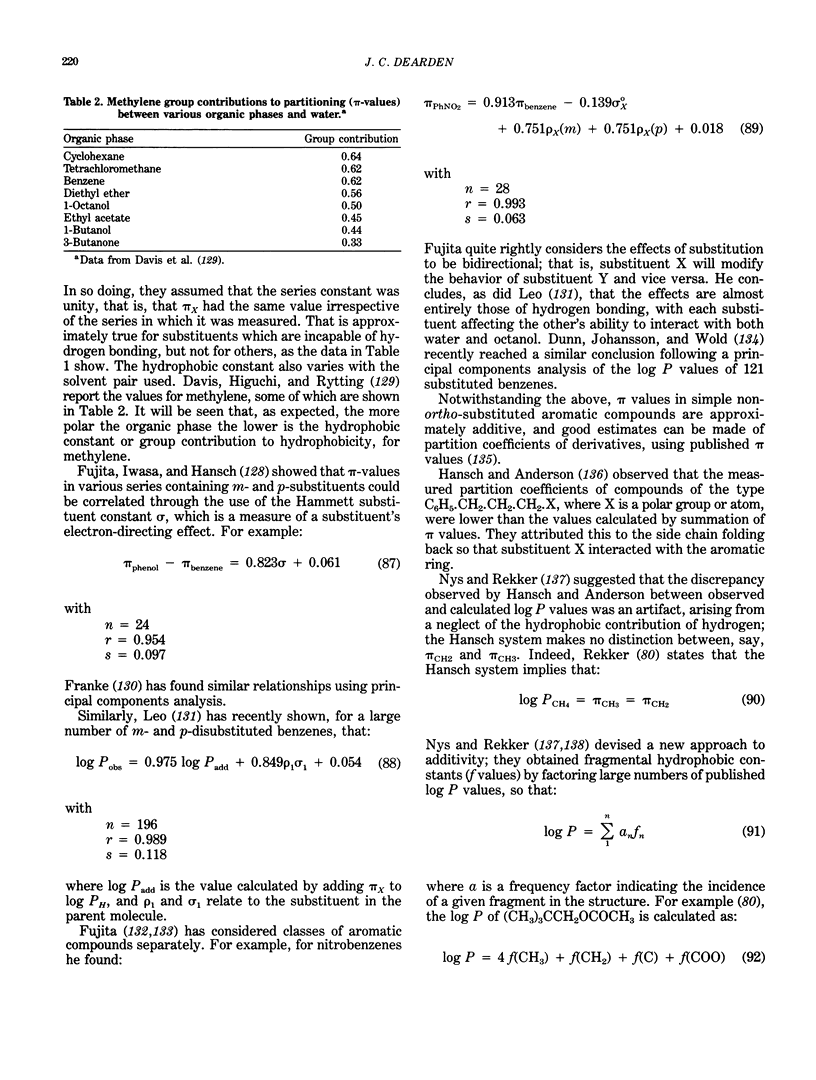
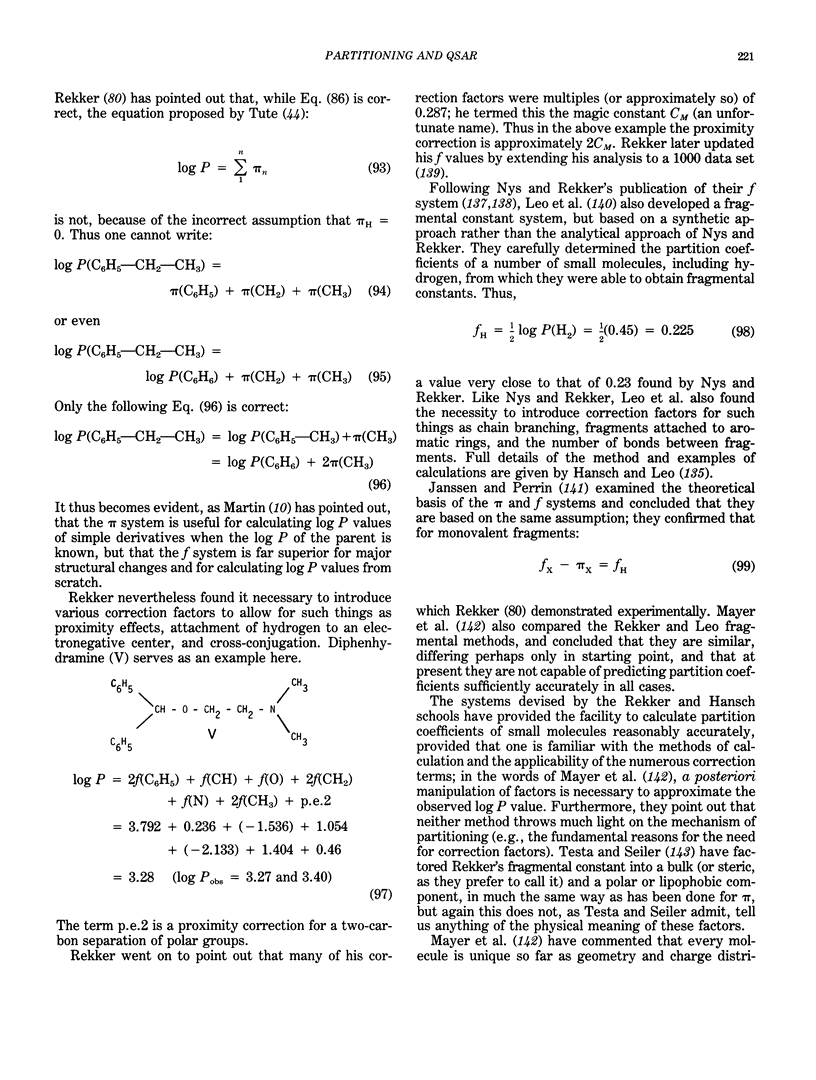
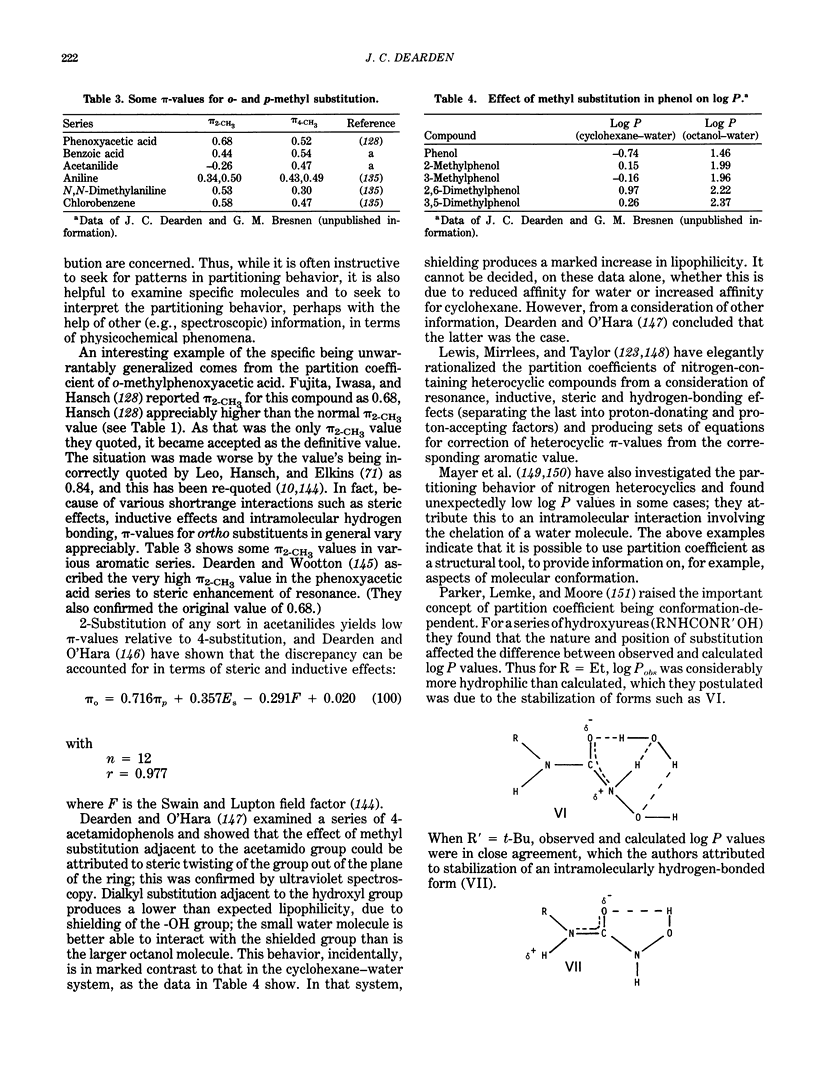
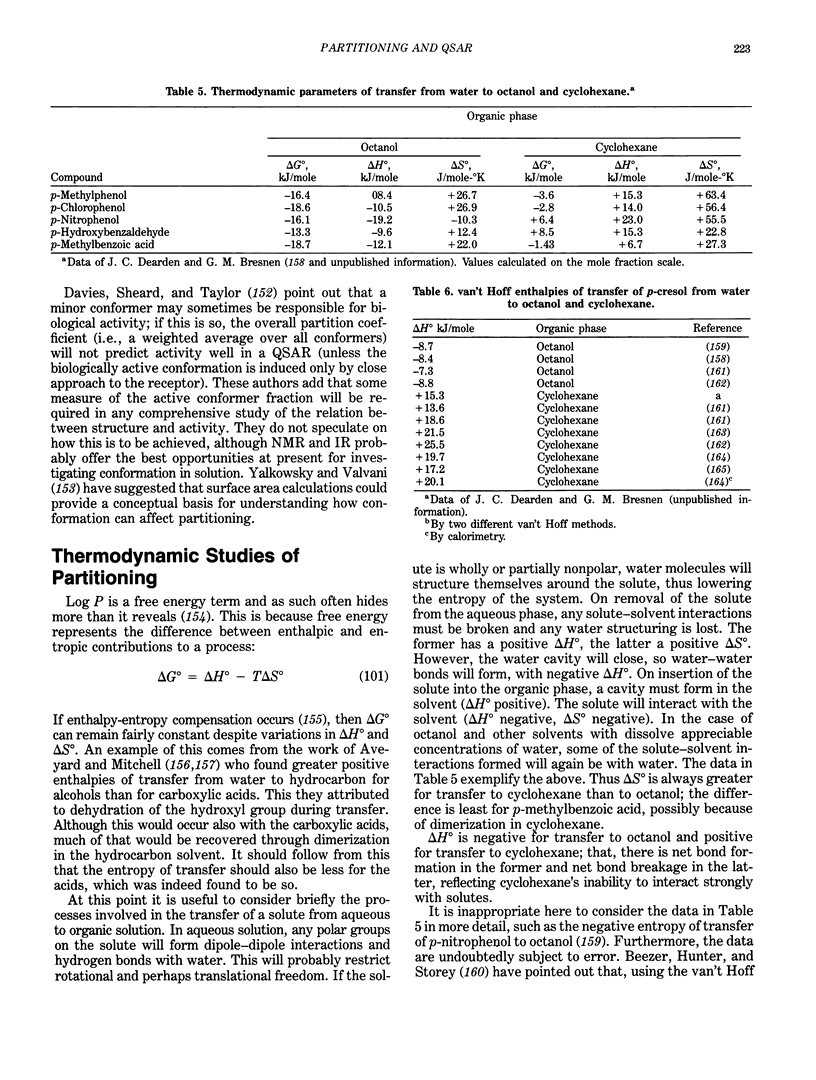
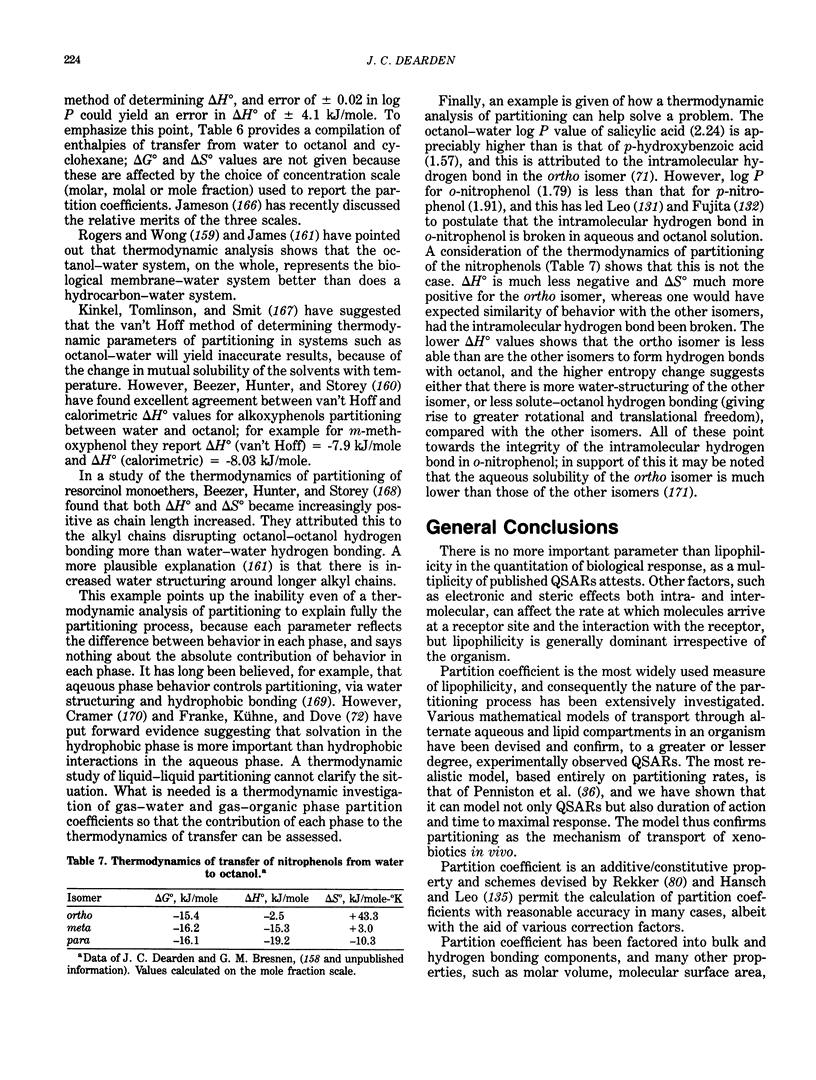
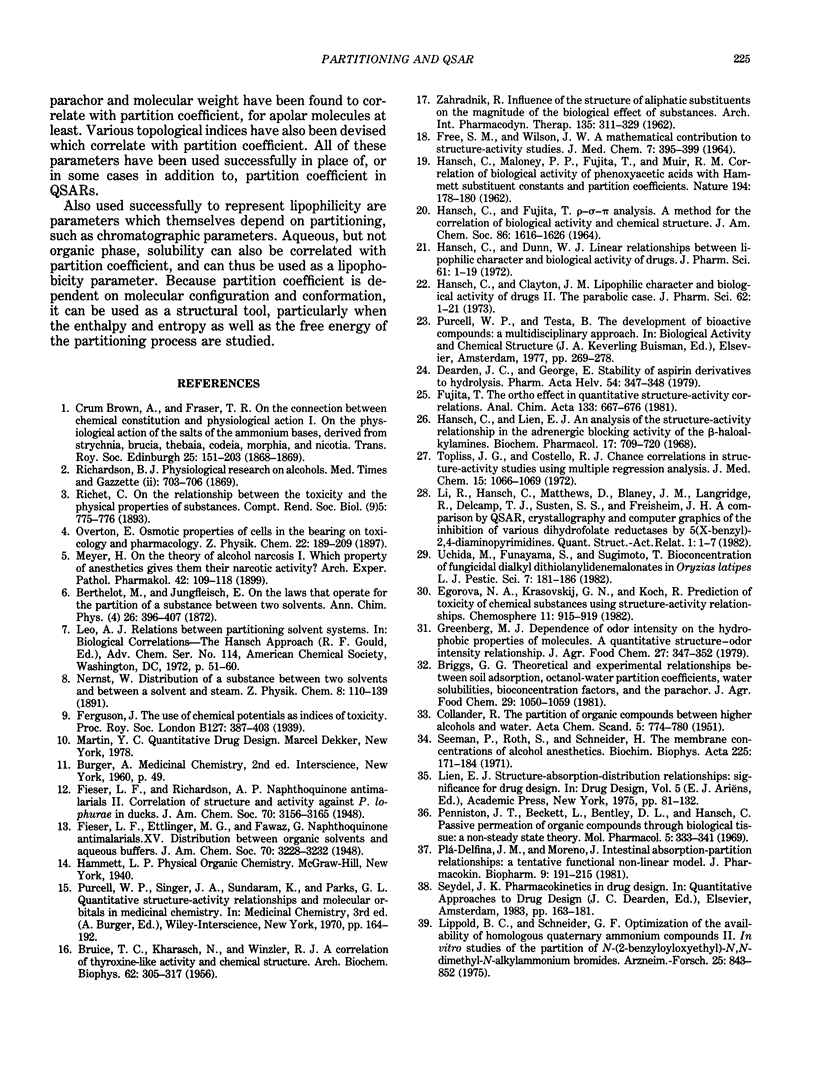
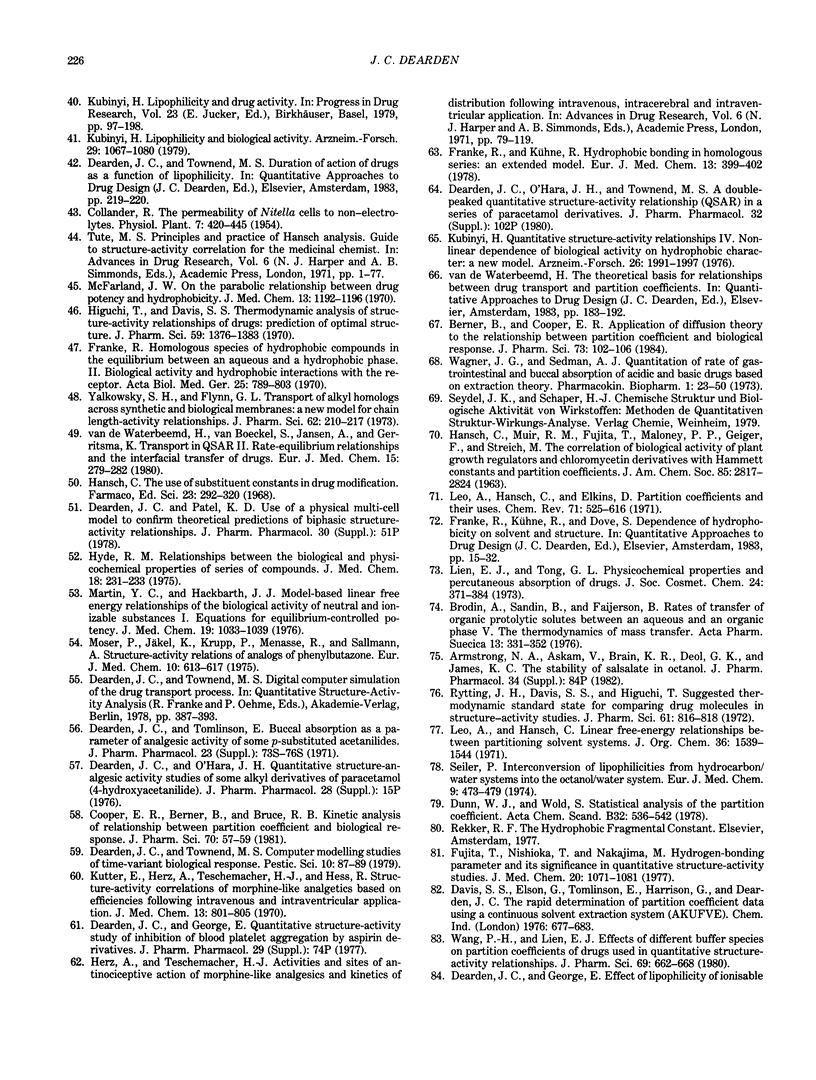
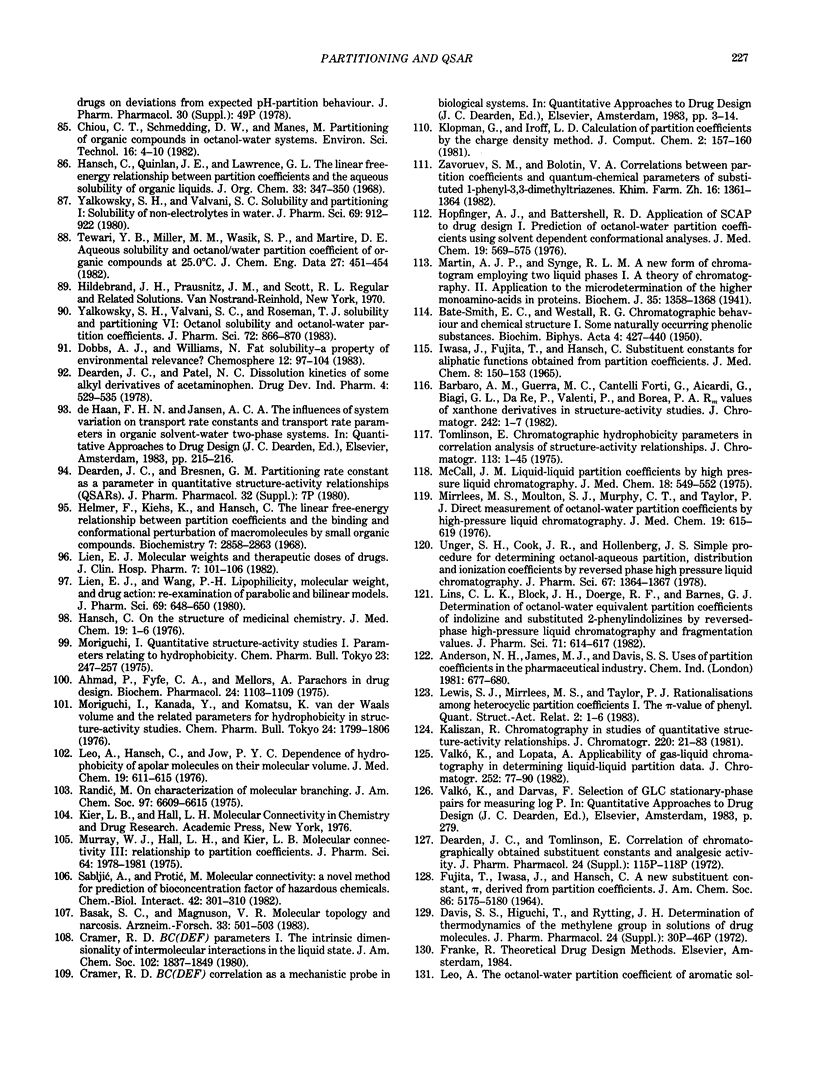
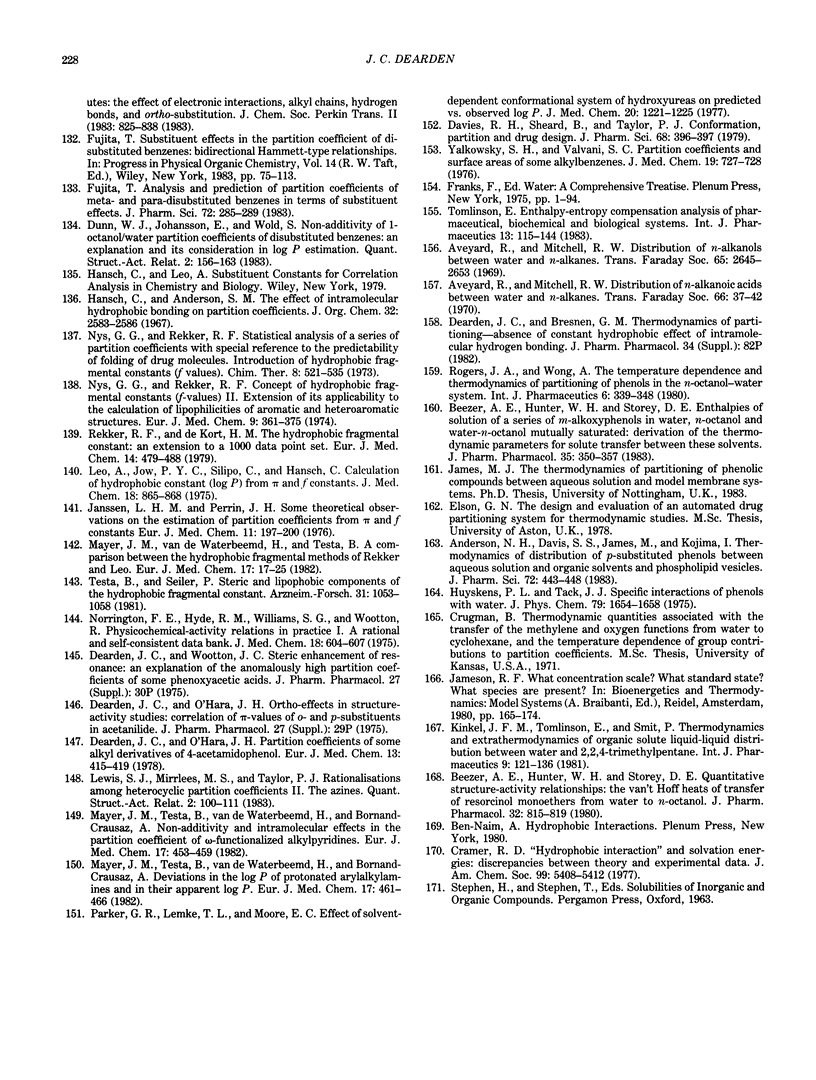
Selected References
These references are in PubMed. This may not be the complete list of references from this article.
- Ahmad P., Fyfe C. A., Mellors A. Parachors in drug design. Biochem Pharmacol. 1975 May 15;24(10):1103–1100. doi: 10.1016/0006-2952(75)90198-7. [DOI] [PubMed] [Google Scholar]
- Anderson N. H., Davis S. S., James M., Kojima I. Thermodynamics of distribution of p-substituted phenols between aqueous solution and organic solvents and phospholipid vesicles. J Pharm Sci. 1983 Apr;72(4):443–448. doi: 10.1002/jps.2600720430. [DOI] [PubMed] [Google Scholar]
- BRUICE T. C., KHARASCH N., WINZLER R. J. A correlation of thyroxine-like activity and chemical structure. Arch Biochem Biophys. 1956 Jun;62(2):305–317. doi: 10.1016/0003-9861(56)90129-1. [DOI] [PubMed] [Google Scholar]
- Barbaro A. M., Guerra M. C., Forti G. C., Aicardi G., Biagi G. L., Da Re P., Valenti P., Borea P. A. RM values of xanthone derivatives in structure-activity studies. J Chromatogr. 1982 Jun 18;242(1):1–7. doi: 10.1016/s0021-9673(00)87242-8. [DOI] [PubMed] [Google Scholar]
- Basak S. C., Magnuson V. R. Molecular topology and narcosis. A quantitative structure-activity relationship (QSAR) study of alcohols using complementary information content (CIC). Arzneimittelforschung. 1983;33(4):501–503. [PubMed] [Google Scholar]
- Beezer A. E., Hunter W. H., Storey D. E. Enthalpies of solution of a series of m-alkoxy phenols in water, n-octanol and water-n-octanol mutually saturated: derivation of the thermodynamic parameters for solute transfer between these solvents. J Pharm Pharmacol. 1983 Jun;35(6):350–357. doi: 10.1111/j.2042-7158.1983.tb02955.x. [DOI] [PubMed] [Google Scholar]
- Beezer A. E., Hunter W. H., Storey D. E. Quantitative structure-activity relationships: the Van't Hoff heats of transfer of resorcinol monoethers from water to n-octanol. J Pharm Pharmacol. 1980 Dec;32(12):815–819. doi: 10.1111/j.2042-7158.1980.tb13082.x. [DOI] [PubMed] [Google Scholar]
- Berner B., Cooper E. R. Application of diffusion theory to the relationship between partition coefficient and biological response. J Pharm Sci. 1984 Jan;73(1):102–106. doi: 10.1002/jps.2600730127. [DOI] [PubMed] [Google Scholar]
- Brodin A., Sandin B., Faijerson B. Rates of transfer of organic protolytic solutes between an aqueous and an organic phase. V. The thermodynamics of mass transfer. Acta Pharm Suec. 1976;13(4):331–352. [PubMed] [Google Scholar]
- Cooper E. R., Berner B., Bruce R. D. Kinetic analysis of relationship between partition coefficient and biological response. J Pharm Sci. 1981 Jan;70(1):57–59. doi: 10.1002/jps.2600700110. [DOI] [PubMed] [Google Scholar]
- Davies R. H., Sheard B., Taylor P. J. Conformation, partition, and drug design. J Pharm Sci. 1979 Mar;68(3):396–397. doi: 10.1002/jps.2600680345. [DOI] [PubMed] [Google Scholar]
- Davis S. S., Higuchi T., Rytting J. H. Determination of thermodynamics of the methylene group in solutions of drug molecules. J Pharm Pharmacol. 1972 Dec;24(Suppl):30P–46P. [PubMed] [Google Scholar]
- Dearden J. C., George E. Effect of lipophilicity of ionisable drugs on deviations from expected pH-partition behaviour [proceedings]. J Pharm Pharmacol. 1978 Dec;30 (Suppl):49P–49P. doi: 10.1111/j.2042-7158.1978.tb10756.x. [DOI] [PubMed] [Google Scholar]
- Dearden J. C., George E. Quantitative structure-activity study of inhibition of blood platelet aggregation by aspirin derivatives [proceedings]. J Pharm Pharmacol. 1977 Dec;29 (Suppl):74P–74P. doi: 10.1111/j.2042-7158.1977.tb11542.x. [DOI] [PubMed] [Google Scholar]
- Dearden J. C., George E. Stability of aspirin derivatives to hydrolysis. Pharm Acta Helv. 1979;54(11):347–348. [PubMed] [Google Scholar]
- Dearden J. C., O'Hara J. H. Proceedings: Ortho-effects in structure-activity studies; correlation of pie values of o- and p-substituents in acetanilide. J Pharm Pharmacol. 1975 Dec;27 (SUPPL?-2):29P–29P. [PubMed] [Google Scholar]
- Dearden J. C., O'Hara J. H. Quantitative structure-analgesic activity studies of some alkyl derivatives of paracetamol (4-hydroxyacetanilide [proceeding]. J Pharm Pharmacol. 1976 Dec;28 (Suppl):15P–15P. [PubMed] [Google Scholar]
- Dearden J. C., Patel K. D. Use of a physical multi-cell model to confirm theoretical predictions of biphasic structure-activity relationships [proceedings]. J Pharm Pharmacol. 1978 Dec;30 (Suppl):51P–51P. doi: 10.1111/j.2042-7158.1978.tb10758.x. [DOI] [PubMed] [Google Scholar]
- Dearden J. C., Tomlinson E. Buccal absorption as a parameter of analgesic activity of some p-substituted acetanilides. J Pharm Pharmacol. 1971 Dec;23:73S–76S. doi: 10.1111/j.2042-7158.1971.tb08772.x. [DOI] [PubMed] [Google Scholar]
- Dearden J. C., Tomlinson E. Correlation of chromatographically obtained substituent constants and analgesic activity. J Pharm Pharmacol. 1972 Dec;24(Suppl):115P–1118. [PubMed] [Google Scholar]
- Dearden J. C., Wootton J. C. Proceedings: Steric enhancement of resonance: an explanation of the anomalously high partition coefficients of some phenoxyacetic acids. J Pharm Pharmacol. 1975 Dec;27 (SUPPL?-2):30P–30P. [PubMed] [Google Scholar]
- FREE S. M., Jr, WILSON J. W. A MATHEMATICAL CONTRIBUTION TO STRUCTURE-ACTIVITY STUDIES. J Med Chem. 1964 Jul;7:395–399. doi: 10.1021/jm00334a001. [DOI] [PubMed] [Google Scholar]
- Franke R. Homologe Serien hydrophober Verbindungen im Gleichgewicht zwischen einer wässigen und einer hydrophoben Phase. II. Biologische Aktivität und hydrophobe Wechselwirkungen mit dem Rezeptor. Acta Biol Med Ger. 1970;25(5):789–803. [PubMed] [Google Scholar]
- Fujita T. Analysis and prediction of partition coefficients of meta- and para-disubstituted benzenes in terms of substituent effects. J Pharm Sci. 1983 Mar;72(3):285–289. doi: 10.1002/jps.2600720319. [DOI] [PubMed] [Google Scholar]
- Fujita T., Nishioka T., Nakajima M. Hydrogen-bonding parameter and its significance in quantitative structure--activity studies. J Med Chem. 1977 Aug;20(8):1071–1081. doi: 10.1021/jm00218a017. [DOI] [PubMed] [Google Scholar]
- Hansch C., Clayton J. M. Lipophilic character and biological activity of drugs. II. The parabolic case. J Pharm Sci. 1973 Jan;62(1):1–21. doi: 10.1002/jps.2600620102. [DOI] [PubMed] [Google Scholar]
- Hansch C., Dunn W. J., 3rd Linear relationships between lipophilic character and biological activity of drugs. J Pharm Sci. 1972 Jan;61(1):1–19. doi: 10.1002/jps.2600610102. [DOI] [PubMed] [Google Scholar]
- Hansch C., Lien E. J. An analysis of the structure-activity relationship in the adrenergic blocking activity of the beta-haloalkylamines. Biochem Pharmacol. 1968 May;17(5):709–720. doi: 10.1016/0006-2952(68)90007-5. [DOI] [PubMed] [Google Scholar]
- Hansch C. On the structure of medicinal chemistry. J Med Chem. 1976 Jan;19(1):1–6. doi: 10.1021/jm00223a001. [DOI] [PubMed] [Google Scholar]
- Hansch C. The use of substituent constants in drug modification. Farmaco Sci. 1968 Apr;23(4):293–320. [PubMed] [Google Scholar]
- Helmer F., Kiehs K., Hansch C. The linear free-energy relationship between partition coefficients and the binding and conformational perturbation of macromolecules by small organic compounds. Biochemistry. 1968 Aug;7(8):2858–2863. doi: 10.1021/bi00848a023. [DOI] [PubMed] [Google Scholar]
- Higuchi T., Davis S. S. Thermodynamic analysis of structure-activity relationships of drugs. Prediction of optimal structure. J Pharm Sci. 1970 Oct;59(10):1376–1383. doi: 10.1002/jps.2600591003. [DOI] [PubMed] [Google Scholar]
- Hopfinger A. J., Battershell R. D. Application of SCAP to drug design. 1. Prediction of octanol-water partition coefficients using solvent-dependent conformational analyses. J Med Chem. 1976 May;19(5):569–573. doi: 10.1021/jm00227a001. [DOI] [PubMed] [Google Scholar]
- Hyde R. M. Relationships between the biological and physicochemical properties of series of compounds. J Med Chem. 1975 Mar;18(3):231–233. doi: 10.1021/jm00237a001. [DOI] [PubMed] [Google Scholar]
- IWASA J., FUJITA T., HANSCH C. SUBSTITUENT CONSTANTS FOR ALIPHATIC FUNCTIONS OBTAINED FROM PARTITION COEFFICIENTS. J Med Chem. 1965 Mar;8:150–153. doi: 10.1021/jm00326a002. [DOI] [PubMed] [Google Scholar]
- Kaliszan R. Chromatography in studies of quantitative structure-activity relationships. J Chromatogr. 1981 May 1;220(1):71–83. doi: 10.1016/s0021-9673(00)98504-2. [DOI] [PubMed] [Google Scholar]
- Kubinyi H. Lipophilicity and biological acitivity. Drug transport and drug distribution in model systems and in biological systems. Arzneimittelforschung. 1979;29(8):1067–1080. [PubMed] [Google Scholar]
- Kubinyi H. Lipophilicity and drug activity. Prog Drug Res. 1979;23:97–198. doi: 10.1007/978-3-0348-7105-1_5. [DOI] [PubMed] [Google Scholar]
- Kubinyi H. Quantitative structure-activity relationships. IV. Non-linear dependence of biological activity on hydrophobic character: a new model. Arzneimittelforschung. 1976;26(11):1991–1997. [PubMed] [Google Scholar]
- Kutter E. Structure-activity correlations of morphine-like analgetics based on efficiencies following intravenous and intraventricular application. J Med Chem. 1970 Sep;13(5):801–805. doi: 10.1021/jm00299a003. [DOI] [PubMed] [Google Scholar]
- Leo A., Hansch C., Jow P. Y. Dependence of hydrophobicity of apolar molecules on their molecular volume. J Med Chem. 1976 May;19(5):611–615. doi: 10.1021/jm00227a007. [DOI] [PubMed] [Google Scholar]
- Leo A., Jow P. Y., Silipo C., Hansch C. Calculation of hydrophobic constant (log P) from pi and f constants. J Med Chem. 1975 Sep;18(9):865–868. doi: 10.1021/jm00243a001. [DOI] [PubMed] [Google Scholar]
- Lien E. J. Molecular weight and therapeutic dose of drug. J Clin Hosp Pharm. 1982 Jun;7(2):101–106. doi: 10.1111/j.1365-2710.1982.tb01009.x. [DOI] [PubMed] [Google Scholar]
- Lien E. J., Wang P. H. Lipophilicity, molecular weight, and drug action: reexamination of parabolic and bilinear models. J Pharm Sci. 1980 Jun;69(6):648–650. doi: 10.1002/jps.2600690610. [DOI] [PubMed] [Google Scholar]
- Lins C. L., Block J. H., Doerge R. F., Barnes G. J. Determination of octanol-water equivalent partition coefficients of indolizine and substituted 2-phenylindolizines by reversed-phase high-pressure liquid chromatography and fragmentation values. J Pharm Sci. 1982 Jun;71(6):614–617. doi: 10.1002/jps.2600710604. [DOI] [PubMed] [Google Scholar]
- Martin A. J., Synge R. L. A new form of chromatogram employing two liquid phases: A theory of chromatography. 2. Application to the micro-determination of the higher monoamino-acids in proteins. Biochem J. 1941 Dec;35(12):1358–1368. doi: 10.1042/bj0351358. [DOI] [PMC free article] [PubMed] [Google Scholar]
- Martin Y. C., Hackbarth J. J. Theoretical model-based equations for the linear free energy relationships of the biological activity of ionizable substances. 1. Equilibrium-controlled potency. J Med Chem. 1976 Aug;19(8):1033–1039. doi: 10.1021/jm00230a012. [DOI] [PubMed] [Google Scholar]
- McCall J. M. Liquid-lipquid partition coefficients by high-pressure liquid chromatography. J Med Chem. 1975 Jun;18(6):549–552. doi: 10.1021/jm00240a003. [DOI] [PubMed] [Google Scholar]
- McFarland J. W. On the parabolic relationship between drug potency and hydrophobicity. J Med Chem. 1970 Nov;13(6):1192–1196. doi: 10.1021/jm00300a040. [DOI] [PubMed] [Google Scholar]
- Mirrlees M. S., Moulton S. J., Murphy C. T., Taylor P. J. Direct measurement of octanol-water partition coefficients by high-pressure liquid chromatography. J Med Chem. 1976 May;19(5):615–619. doi: 10.1021/jm00227a008. [DOI] [PubMed] [Google Scholar]
- Murray W. J., Hall L. H., Kier L. B. Molecular connectivity. III: Relationship to partition coefficients. J Pharm Sci. 1975 Dec;64(12):1978–1981. doi: 10.1002/jps.2600641216. [DOI] [PubMed] [Google Scholar]
- Norrington F. E., Hyde R. M., Williams S. G., Wootton R. Physiochemical-activity relations in practice. 1. A rational and self-consistent data bank. J Med Chem. 1975 Jun;18(6):604–607. doi: 10.1021/jm00240a016. [DOI] [PubMed] [Google Scholar]
- Parker G. R., Lemke T. L., Moore E. C. Effect of the solvent-dependent conformational system of hydroxyureas on predicted vs. observed log P. J Med Chem. 1977 Sep;20(9):1221–1225. doi: 10.1021/jm00219a024. [DOI] [PubMed] [Google Scholar]
- Penniston J. T., Beckett L., Bentley D. L., Hansch C. Passive permeation of organic compounds through biological tissue: a non-steady-state theory. Mol Pharmacol. 1969 Jul;5(4):333–341. [PubMed] [Google Scholar]
- Plá-Delfina J. M., Moreno J. Intestinal absorption-partition relationships: a tentative functional nonlinear model. J Pharmacokinet Biopharm. 1981 Apr;9(2):191–215. doi: 10.1007/BF01068082. [DOI] [PubMed] [Google Scholar]
- Rytting J. H., Davis S. S., Higuchi T. Suggested thermodynamic standard state for comparing drug molecules in structure-activity studies. J Pharm Sci. 1972 May;61(5):816–818. doi: 10.1002/jps.2600610541. [DOI] [PubMed] [Google Scholar]
- Sabljić A., Protić M. Molecular connectivity: a novel method for prediction of bioconcentration factor of hazardous chemicals. Chem Biol Interact. 1982 Dec;42(3):301–310. doi: 10.1016/0009-2797(82)90074-6. [DOI] [PubMed] [Google Scholar]
- Seeman P., Roth S., Schneider H. The membrane concentrations of alcohol anesthetics. Biochim Biophys Acta. 1971 Feb 2;225(2):171–184. doi: 10.1016/0005-2736(71)90210-0. [DOI] [PubMed] [Google Scholar]
- Testa B., Seiler P. Steric and lipophobic components of the hydrophobic fragmental constant. Arzneimittelforschung. 1981;31(7):1053–1058. [PubMed] [Google Scholar]
- Tomlinson E. Chromatographic hydrophobic parameters in correlation analysis of structure-activity relationships. J Chromatogr. 1975 Mar 12;113(1):1–45. doi: 10.1016/s0021-9673(00)88797-x. [DOI] [PubMed] [Google Scholar]
- Topliss J. G., Costello R. J. Change correlations in structure-activity studies using multiple regression analysis. J Med Chem. 1972 Oct;15(10):1066–1068. doi: 10.1021/jm00280a017. [DOI] [PubMed] [Google Scholar]
- Tute M. S. Principles and practice of Hansch analysis: a guide to structure-activity correlation for the medicinal chemist. Adv Drug Res. 1971;6:1–77. [PubMed] [Google Scholar]
- Unger S. H., Cook J. R., Hollenberg J. S. Simple procedure for determining octanol--aqueous partition, distribution, and ionization coefficients by reversed-phase high-pressure liquid chromatography. J Pharm Sci. 1978 Oct;67(10):1364–1367. doi: 10.1002/jps.2600671008. [DOI] [PubMed] [Google Scholar]
- Wang P. H., Lien E. J. Effects of different buffer species on partition coefficients of drugs used in quantitative structure-activity relationships. J Pharm Sci. 1980 Jun;69(6):662–668. doi: 10.1002/jps.2600690614. [DOI] [PubMed] [Google Scholar]
- Yalkowsky S. H., Flynn G. L. Transport of alkyl homologs across synthetic and biological membranes: a new model for chain length-activity relationships. J Pharm Sci. 1973 Feb;62(2):210–217. doi: 10.1002/jps.2600620205. [DOI] [PubMed] [Google Scholar]
- Yalkowsky S. H., Valvani S. C. Partition coefficients and surface areas of some alkylbenzenes. J Med Chem. 1976 May;19(5):727–728. doi: 10.1021/jm00227a031. [DOI] [PubMed] [Google Scholar]
- Yalkowsky S. H., Valvani S. C., Roseman T. J. Solubility and partitioning VI: octanol solubility and octanol-water partition coefficients. J Pharm Sci. 1983 Aug;72(8):866–870. doi: 10.1002/jps.2600720808. [DOI] [PubMed] [Google Scholar]
- Yalkowsky S. H., Valvani S. C. Solubility and partitioning I: Solubility of nonelectrolytes in water. J Pharm Sci. 1980 Aug;69(8):912–922. doi: 10.1002/jps.2600690814. [DOI] [PubMed] [Google Scholar]
- ZAHRADNIK R. Influence of the structure of aliphatic substituents on the magnitude of the biological effect of substances. Arch Int Pharmacodyn Ther. 1962 Feb 1;135:311–329. [PubMed] [Google Scholar]


